The American Medical Association (AMA) recently released a study showing the increasing uncertainty patients have over medical expenses. Among the main offenders is one apparently enigmatic CPT code list. But worry not more! This book reveals the secrets of these codes so that you may know what you are being charged for.
CPT codes: what are they?
Current Procedural Terminology, or CPT, codes are a uniform medical language applied all throughout the United States. Designed by the AMA, these five-digit codes classify an extensive range of medical treatments and operations carried out by different healthcare facilities. Every service—from a basic office visit to a sophisticated surgery—has a CPT code. These codes help insurance companies decide rates of coverage and reimbursement.
Why Should Consumers Know CPT Codes?
Knowing CPT rules helps patients to take active part in their treatment. Knowing the codes connected to a service will enable you:
Reviewing your medical bill and noting the CPT codes mentioned will help you to confirm whether the billed services match what you received. Should you find any differences, you can get explanation from the billing department of your provider.
Many hospitals and clinics include web cost estimators using CPT codes. Researching the CPT codes connected to a scheduled operation helps you to estimate the possible expenses ahead. This information can support planning and budgeting for medical costs.
Make wise decisions based on hints about the kind and complexity of a service found in CPT codes. Knowing the CPT code for a suggested test or treatment will inspire you to ask your doctor more questions regarding its need and possible substitutes.
Common CPT Code Classification
CPT codes’ large universe is arranged according to the type of service rendered into several groups. Here is a snapshot of some often occurring categories:
E/M, or evaluation and management, codes: These codes show visits to your doctor’s office and consultations. The particular E/M code depends on elements including the degree of the examination carried out, the complexity of the medical decision-making engaged in, and the time spent with the doctor.
From minimally invasive laparoscopic operations to sophisticated open procedures, this category includes several surgical techniques. The coding captures the kind of operation, the body area engaged, and the technique applied.
Medical codes stand for treatments including injections, vaccinations, and therapeutic operations. A code might specify, for example, how to administer a certain drug or do a drainage operation.
Radiology codes address X-rays, CT scans, and MRIs among other diagnostic imaging techniques. The code notes the bodily part under examination and the kind of imaging done.
Pathology and Laboratory Codes: Blood tests, tissue biopsies, cytology analyses, and other laboratory tests and pathology services carried out on patient specimens are represented in codes under this subcategory.
Locating a CPT Code List
Although patients may find a complete list of CPT codes to be daunting, several tools might offer a window into the codes connected with particular services. Here are a few possibilities:
Many healthcare providers include CPT codes related with popular procedures on their webpages on hospital or clinic websites.
Several web programs let you search for treatments by name or description and offer approximative charges based on related CPT codes.
Speak with your doctor: Ask your doctor straight forwardly about the CPT codes connected to a suggested test or treatment without delay.
Though first intimidating, knowing CPT codes will help you to more confidently handle medical costs. Demystifying these rules helps you to be a more informed and empowered patient who participates actively in your healthcare path.

